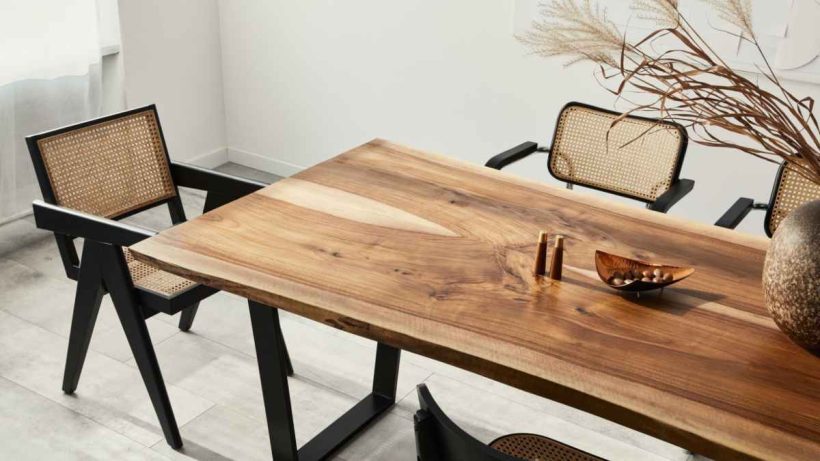The wood table top has endured over time in interior design, where fashions come and go. Wood has continued to be a preferred material for creating beautiful and helpful table tops because of its inherent beauty, toughness, and adaptability. Wood’s attraction is not just aesthetic; it also stems from its long history, sustainability, and the distinctive personality it gives each item. To better understand why wood table tops continue to capture our attention, we will examine their history, advantages, kinds, and care in this article.
THE RICH HISTORY OF WOOD TABLE TOPS
Since ancient times, wood has played a significant role in human civilization. Wood helped make buildings, but early civilizations also learned how to use it to make furniture, including tabletops. Wood has significantly influenced how our living spaces have been designed, from the elaborate patterns of Egyptian hardwood tables to the sturdy oak tables of medieval Europe. It has been a popular option throughout all times and civilizations because of its accessibility, practicability, and ageless appeal.
BENEFITS OF WOOD TABLE TOPS
· NATURAL BEAUTY
Wood table tops’ inherent beauty is one of its most alluring features. Different wood species’ distinctive grain patterns, colors, and textures give each room a sense of cosines and personality. Wood table tops may go well with various interior design aesthetics, whether the slick elegance of cherry wood or the rustic appeal of reclaimed oak.
· LONGEVITY AND DURABILITY
Wood is well known for its longevity, making it an excellent investment for furniture made to withstand everyday usage. A high-quality wood tabletop may last decades if cared for properly, preserving the memories of innumerable get-togethers and shared meals.
· VERSATILITY
Wood may be carved into many styles and forms, opening various tabletop designs. Wood may be customized to your tastes, whether you like a sleek, modern aesthetic or a classic, traditional style.
· SUSTAINABILITY
As environmental conservation concerns increase, the sustainability of wood is highlighted. Wood table tops are an environmentally favorable option since responsible sourcing and certification programmers guarantee that the wood used in furniture manufacture originates from well-managed forests.
· ADAPTABILITY
It is simple to repair and restore wood table tops. An antique object may frequently be given new life by sanding off surface scratches, dents, and stains.
TYPES OF WOOD TABLE TOPS
· HARD WOOD
Hardwood species, including oak, maple, cherry, and walnut, are highly valued for their strength and beautiful colors. Traditional designs frequently use oak because of its pronounced grain, whereas contemporary designs benefit from maple’s smooth surface.
· SOFTWOODS
Softwood species like cedar and pine provide a more informal, rustic look. Even though softer than hardwoods, they may still be used for table tops if properly polished and maintained.
· EXOTIC WOODS
Exotic woods with unusual colors and characteristic grain patterns include mahogany, teak, and rosewood. These woods are excellent options for high-end furniture since they frequently have a luxury character.
· RECLAIMED WOOD
Reclaimed wood comes from historic buildings, barns, and storage facilities and has a unique history. It enhances a space’s authenticity and sustainability by reusing materials that may otherwise be thrown away.
MAINTAINING WOOD TABLE TOP
To preserve the life and beauty of wood table tops, proper care is necessary:
· REGULAR CLEANING
Dust the surface often to keep it free of scratches and to preserve its luster. For general cleaning, use a soft, wet cloth.
· AVOID MOISTURE
Steer clear of moisture since wood is sensitive to variations in moisture content. Use tablecloths, placemats, and coasters to shield the surface from heat and spillage.
· PROTECTIVE FINISHES
Applying a protective finish, such as varnish, lacquer, or wax, helps preserve wood against stains, scratches, and UV deterioration.
· AVOID DIRECT SUNLIGHT
Wood can fade and dry up when exposed to direct sunlight over time. Place your table away from windows, or cover it with drapes to block sunlight.
· REGULAR POLISHING
It maintained the wood’s inherent beauty and enhanced its shine with routine polishing using suitable materials.
Laila Azzahra is a professional writer and blogger that loves to write about technology, business, entertainment, science, and health.
